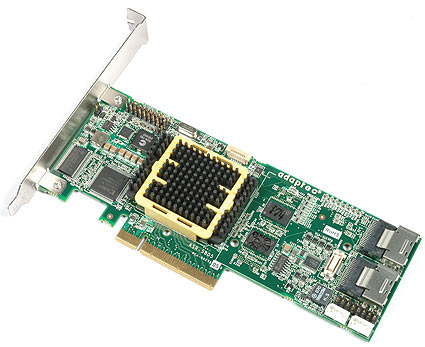Adaptec's Series 5 Unified Serial Controllers
Adaptec Turns Up The Heat On Unified Serial Storage
A RAID controller certainly isn’t a product that users buy at retail. Although almost all controller products are indeed available through e-tail and retail channels, more typical customers are system builders who require the controller to power their storage solutions. The new Adaptec Series 5 RAID controller family is designed to power workstations, servers with DAS storage, SAN appliances, NAS storage and other related solutions, which are crucial for small, medium and large businesses. We wanted to know how the new combined SAS/SATA cards compare to the established competition, and that’s what we’re going to find out.
Storage controller cards were once an essential component of PCs, providing the basic connectivity for drives that is now built into chipsets. No longer needed in that market, storage add-on cards have now moved into business segments with specific applications. Servers and workstation systems typically require sophisticated RAID controllers; high-end desktops or enthusiast systems don’t. But the current generation of RAID controller cards is not only powerful and extremely flexible, but also amazingly scalable - they can be used with low-cost SATA or high-end SAS hard drives, hooking up drives internally or externally. (Compare Prices on Adaptec RAID Controllers)
Before the introduction of SAS (Serial Attached SCSI), a controller’s market positioning was defined purely by its interface: UltraATA or SATA controllers were entry-level hardware for SMBs, while SCSI products catered to enterprise applications due to their more sophisticated features and flexible connectivity. Today, SAS controllers are referred to as Unified Serial controllers, which means that a SAS device can handle and even mix both SAS and SATA hard drives. Each SAS controller offers a certain number of ports, but SAS allows you to run four 300 MB/s SAS connections through a multi-lane cable for drives or expanders. SAS edge expanders enable administrators to connect additional drive appliances to create a so-called SAS domain. All drives in such a domain - which has similarities to Ethernet with its switches - are managed by the Unified Serial controller.
The Unified Serial controller market must be differentiated based on port count - since sophisticated models require tremendous internal bandwidth - as well as feature set. Unified Serial RAID can also be created by having the system processor take care of all processing workloads (host-based RAID), or by providing dedicated hardware acceleration (hardware RAID).
Adaptec’s new Series 5 PCI Express RAID controllers are based on a 1.2 GHz dual core storage processor, provide a very comprehensive feature set, and come in eight different flavors with four to 28 ports in internal and/or external port configurations. Let’s look at them in detail.
Join our discussion on this article!
Get Tom's Hardware's best news and in-depth reviews, straight to your inbox.
Current page: Adaptec Turns Up The Heat On Unified Serial Storage
Next Page Storage Controller Fundamentals
Patrick Schmid was the editor-in-chief for Tom's Hardware from 2005 to 2006. He wrote numerous articles on a wide range of hardware topics, including storage, CPUs, and system builds.
-
Fedor The degraded figures for streaming writes don't look right. They are too close (or above??) the normal/optimal state numbers. One idea that comes to mind is that if the writes were too small, they would all go into the cache regardless and render the results somewhat useless.Reply -
h4vok FedorThe degraded figures for streaming writes don't look right. They are too close (or above??)The figures look OK. Sequential writes to a degraded array are basically done the same way as writes to an optimal array. The only difference is that the write to the failed drive is skipped.Reply -
guan1307 I am confused your testing report , due to Our testing figure of Areca ARC-1680 firmware 1.45 is better than your report ,Reply -
bull2760 Can someone tell me what Database server pattern, web server pattern, file server pattern mean. When I run iometer those options are not present I can select 4k-32k or create a custom script. Plus at what stripe size are these tests being run at? I purchased this exact controller and have not duplicated TG results. It would be helpful if you explain in detail how you configured the RAID setup. RAID 5, 6 or 10 with a 16k, 32k, 64k, 128k, 256k, 512k or 1MB stripe size.Reply -
I have an ASUS P5K-E/WIFI-AP which has 2 PCI-E x16. The blue one runs at x16 and black can run at x4 or x1.Reply
Will this Adaptec card work on my board?
-
kakashi I think that Tomshardware should run the Areca’s ARC-1680ML test again with the firmware 1.45 and maybe with the latest IOMeter 2006.07.27. Areca claimed that they have better result: http://www.areca.com.tw/indeximg/arc1680performanceqdepth_32%20_vs_%20tomshardwareqdepth_1_test.pdfReply -
MrMickelson Degraded RAID 5 write performance is going to be better than an optimal RAID 5 write because only data stripes are being written opposed to writing data stripes then using XOR to generate the parity stripe thus the write operations will be quicker. Degraded RAID 5 read performance will take a significant hit in performance because rather than just reading only the data stripes for an optimal RAID 5, the available data stripes and available parity stripes will be read then XOR will re-generate this missing data.Reply -
Initializing the controller during POST takes a very long time with Adaptec Raid 3 series, which is very frustrating when used in high performance workstations.Reply
Has this been fixed with the new Raid 5 series ?
-
makaira Turn up the heat all right. I installed a new 5805 in a Lian-Li 7010 case with 8 x 1 Tb Seagate drives, Core 2 Quad 2.83Gb and 800w PSU - more fans than you could poke a stick at.Reply
The controller overheated - reported 99 deg in messages and set off alarm.
That was on drive initiation. We had a range of errors reported from drives, a number of different drives. The array (5.4Tb Raid 6) never completed building and verifying.
CPU temp was 45, motherboard 32, and ambient room temp 22deg.
I installed a 3ware - and all worked fine. Was Tomshardware comment "turns up the heat" written tongue in cheek as there seems to be a heat issue with this card? -
elektrip I'd love to see how this controller performs with some Intel X25-M/E or OCZ Vertex SATA SSDs connected. The tested drives here are probably a bottleneck, not the storage controller. Rather in I/O then sequential though.Reply
